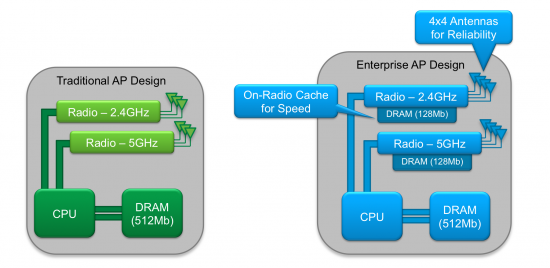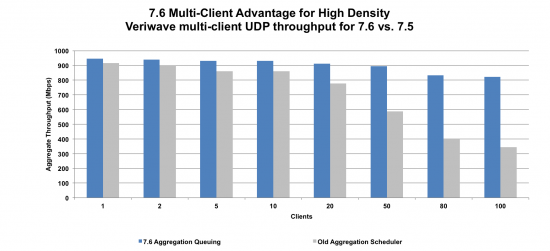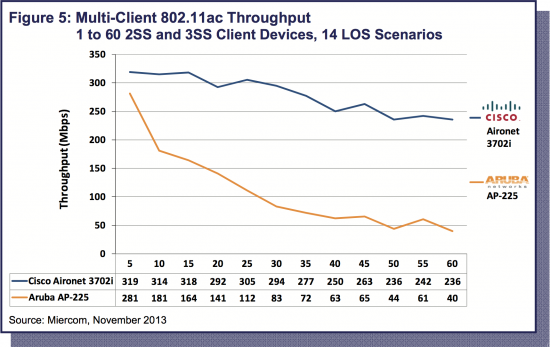































Editor's Note: This is the second of a four-part deep dive series into High Density Experience (HDX), Cisco's latest solution suite designed for high density environments and next-generation wireless technologies. For more on Cisco HDX, visit www.cisco.com/go/80211ac. Read part 1 here.
With any new technology comes a new set of obstacles to overcome. 802.11ac is no exception. Last week we talked about CleanAir for 802.11ac and why spectrum intelligence still matters. Another challenge is scalability. In this post I will give you some details on new HDX feature, Turbo Performance, which allows the AP 3700 overcome common scaling issues to scale amazingly well.
What's Different with 802.11ac?
802.11ac means higher data rates, which means more packets per second (PPS). There are three reasons for more PPS with 11ac: wider channels, increased modulation and increased aggregation. Channel width doubled to 80 MHz, modulation increased from 64 QAM to 256 QAM, and aggregation increased from 64k to 1MB!
With 802.11n, an AP might have had to push 30,000 1500 byte packets per second through the APs data plane. Today with 802.11ac that could now be 75,000+ PPS. More PPS means more load on the APs CPU, so to really keep up with the demands of 802.11ac, we needed to go back to the drawing board.
When designing the Aironet 3700 Access Point, we fundamentally retooled our APs data plane for 802.11ac. We came up with a lightweight packet scheduler -went from a packet-based data plane and scheduler with software version 7.5 to a client-based data plane and scheduler in software version 7.6. The AP 3700 also employs a custom, purpose-built 802.11ac chip where we placed a generous amount of DDR3 RAM right on the radio, which allows us to have many local radio buffers and a highly optimized A-MPDU data plane. This results in a much less CPU intensive processing and much more efficient packet scheduler delivering 802.11ac speeds at much larger scale than the competition.
This graphic shows the traditional AP design versus Enterprise AP design, which we used in the AP3700. In the traditional AP the RAM is placed close to the host CPU, instead of the radios. With the increased speeds of 802.11ac, it's important to have a design like the Enterprise AP 3700, where RAM is placed on the CPUanddirectly on the radios.

7.5 vs. 7.6 Multi-Client Performance
The AP3700 is able to effortlessly handle dozens of clients with minimal performance degradation as the client count increases. The latest Wireless Release 7.6 complements 802.11ac and the new Enterprise AP design to optimize multi-client performance. This chart compares the aggregation scheduler performance in version 7.5 to the new scheduler of version 7.6. Specifically look at the performance improvement with 50+ clients.

Multi-Client Performance vs. The Competition
Let's take a look at how the competition handled the transition to 802.11ac. Miercom recently published a report that put the Cisco AP 3700 head-to-head with the Aruba AP-225. As you can see, the Aruba architecture does not handle increasing numbers of clients very well. The chart shows performance as clients are added, starting with 5 clients and scaling to 60 clients.

Putting it all Together
802.11ac allows for speeds never before seen on a Wi-Fi access point. Cisco understood the new demands from these increased speeds and with HDX Turbo Performance, fundamentally reworked the data plane in order to enable unrivaled 802.11ac performance and scalability.
For more about HDX, go to www.cisco.com/go/80211ac.
Look forward to the next HDX blog post talking about ClientLink 3.0.
 Горячие метки:
802.11ac
access point
Организация Объединенных Наций по промышленному развитию
О компании AP
1. Антенна
cpu
data plane
aggregation scheduler
byte
Горячие метки:
802.11ac
access point
Организация Объединенных Наций по промышленному развитию
О компании AP
1. Антенна
cpu
data plane
aggregation scheduler
byte